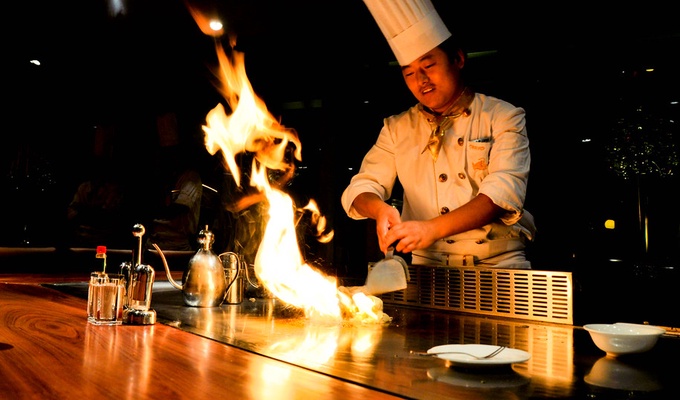Teppanyaki (鉄板焼き), often called hibachi in the United States and Canada, is a post-World War II style of Japanese cuisine that uses an iron griddle to cook food. The word teppanyaki is derived from teppan the metal plate on which it is cooked, and yaki, which means grilled, broiled, or pan-fried. In Japan, teppanyaki refers to dishes cooked using a teppan, including steak, shrimp, okonomiyaki, yakisoba, and monjayaki.
Teppan are typically propane-heated, flat-surfaced, and are widely used to cook food in front of guests at restaurants. They are commonly confused with the hibachi barbecue grill, which is called shichirin in Japanese, and has a charcoal or gas flame and is made with an open grate design. With a solid griddle-type cook surface, the teppan is capable of cooking small or semisolid ingredients such as rice, egg and finely chopped vegetables.
Typical ingredients used for Western-style teppanyaki are beef, shrimp, scallops, lobster, chicken and assorted vegetables. Soybean oil is typically used to cook the ingredients.
Japanese-style teppanyaki may also use noodles (yakisoba) or cabbage with sliced meat or seafood (okonomiyaki), which are cooked using vegetable oil, animal fat, or a mixture. In Japan, many teppanyaki restaurants feature Kobe beef or Wagyu beef.
Side dishes of mung bean sprouts, zucchini (courgettes) (though this is not a popular vegetable in Japan and rarely found in that market), garlic chips (crisps), or fried rice usually accompany the meal. Some restaurants provide sauces in which to dip the food. In Japan, only soy sauce is typically offered.
In the United States
In the United States, teppanyaki (more commonly known simply as hibachi) was made famous by the Benihana restaurant chain, which opened its first restaurant in New York in 1964. Though Benihana cooks their food teppanyaki-style, they also serve dishes such as hibachi steak and chicken. Benihana and other chains of teppanyaki restaurants continue to place an emphasis on the chef performing a show for the diners and continuing to introduce new variations and tricks. The chef might juggle utensils, flip a shrimp tail into their shirt pocket, catch an egg in their hat, toss an egg up in the air and split it with a spatula, or flip flattened shrimp pieces into diners' mouths.
